As a typical representative of the coal chemical industry, the harsh working conditions of solid-liquid-gas three-phase mixing make every designer and user very distressed, and the service life is short and short. This paper analyzes the cause of the problem and the harm caused by three aspects of solid, liquid and gas. Solutions should be proposed from multiple perspectives to provide reference for future designers in the design process.
The improvement of the technological process will definitely promote the progress of the industrial industry, and the demand for technological equipment will drive the development of industrial equipment. Coal chemical industry is an important part of the industrial valve solutions. In the field of coal-to-methanol, coal-to-ethylene, and coal-to-synthesis ammonia, the emergence of coal-water slurry gasification technology has driven the mass production and economicalization of coal chemical industry. At present, the coal-water slurry gasification process has the production safety of mature preparation technology and controllable preparation process; it also has the economy of raw material compatibility and high synthesis conversion efficiency; it also has the advantages of easy construction of equipment and equipment, and short investment return period. sex. In the coal-water slurry gasification process, in addition to the flash tank as the technical core of the synthesis conversion, the black water control valve in the gasifier and the washing tower is also an indispensable component in the whole process as a manifestation of economy and environmental protection. part. The long-term and stable operation of the black water regulating valve affects the continuous production of the gasification plant. However, due to the severe working conditions faced by the black water regulating valve, the extremely short service life and failure probability urge the improvement and progress of the black water regulating valve technology.
No matter what kind of multi-stage process the black water flash distillation system adopts, its essence is to undertake the tasks of flow and liquid level adjustment from the gasifier, scrubber, and flash tank.
Black water is an accompanying product in the production process of scrubbers and gasifiers in the coal-water slurry gasification process. In terms of process tasks, black water needs to be recovered, purified and reused.
The typical medium of black water is solid-liquid two-phase flow. In the solid-phase flow, the solid-phase content can be as high as 3000 mg/L. With multiple recovery and sedimentation, the mass fraction of solid particles can reach 4% or more at most; Its hardness is also very high, the solid phase Mohs hardness can reach 7 Mohs, and the particle diameter and shape are not uniform.
In the liquid phase flow, the liquid contains many strong corrosive ions such as Ca 2 + , Mg2+, Cl-, S2-, CO32-, NH4+, H2S, etc., which will erode the inner wall and parts of the control valve; due to the black water The regulating valve is mostly used for tank bottom recovery and post-tank feeding. The valve itself carries a large amount of liquid. At the same time, due to the requirements of process preparation, the temperature of the medium is mostly 200℃~300℃, which makes the pressure difference before and after the black water regulating valve larger.
When the medium flows through the internal systolic flow section of the regulating valve, according to the throttling principle, if the pressure of the medium does not rise beyond the saturated vapor pressure at the inlet temperature after the medium flows out of the throttling area, the fluid medium will continue to vaporize and form vapor at the outlet of the regulating valve. The phenomenon of the coexistence of liquids, that is, two-phase flow, is called flash evaporation. It is precisely because in the black water flash evaporation system, the main function of the black water control valve is to adjust the pressure of the medium, which will inevitably cause flash evaporation. The volume of the vaporized black water fluid will expand rapidly, and the volume flow after the control valve will be It will be the geometric multiple in front of the regulating valve, and form a solid-liquid-gas three-phase flow with the black water in front of the regulating valve.
The solid-liquid-gas three-phase flow is accompanied by high pressure difference, high flow rate, strong corrosion and strong impact, and the working conditions of the black water control valve can be described as extremely bad. In terms of solid phase, due to the high content of solid phase and the high hardness of particles, under the support of high pressure difference and high flow rate, solid particles will become the first difficulty in the design of control valve. The solid particles under high-speed impact will first hit the parts that hinder the advancement of the fluid passage, such as the valve core, valve seat, valve stem and other parts that play a major adjustment function. These parts are limited by their own processing materials and raw materials Different treatment methods and impact-resistant structures will cause pits, scratches, and even cracks on the surface of the parts. These defects caused by the impact of solid particles will be affected by the flashing and cavitation of the liquid. Erosion itself until the part shatters, bends, or even breaks.
Secondly, the solid particles wear on the path of the fluid passage, which is mainly manifested in the sudden change of direction on the inner wall of the pipeline, the cavity of the valve body due to blocked flow or the turning of the pipeline and the turning of the valve cavity. The inner wall will cause scratches, scratches, and abnormal noises; the change of direction will also affect the flow rate of the local medium, and it will also produce eddy currents and turbulent flow, which will cause vibration and noise in the pipeline and valve cavity, which is also the medium in pipeline transportation and valve adjustment. Potentially dangerous.
Another hazard caused by solid particles is the problem of sedimentation. The solid particles are small and prone to sedimentation and scaling. They are easy to accumulate in the dead corners of the inner cavity of the regulating valve, and crust on the surface of the valve core, valve seat and valve stem, especially when the valve is used. Stem guide area for stabilizing the stem and reducing vibration. Due to the valve stem guiding and stabilizing effect, the gap between the valve stem and the guide will not be too large, and the valve stem will move up and down with the valve opening and closing, which will inevitably drive the particles into the gap between the valve stem and the guide. , which will cause the valve stem and the guide to be stuck, aggravate the wear of the valve stem and the guide surface, and ultimately affect the stability of the valve stem. At the same time, due to the weakening of the guiding and stabilizing effect, the valve core will vibrate under the impact of the liquid and collide with the valve seat, causing secondary damage to the valve core and the valve seat. Due to the wear and scratches on the surface of the valve stem, it will also affect the sealing effect of the upper packing of the regulating valve and the valve stem, resulting in serious production accidents such as black water leakage and toxic gas escape.
In the liquid phase, since the main body of black water is liquid, the liquid contains many strong corrosive ions such as Ca2+, Mg2+, Cl-, S2-, CO32-, NH4+, H2S, etc. With higher temperature, prolonged immersion will adjust the The inner wall of the valve and its parts are eroded, which weakens the oxide protective layer of the metal on the surface of the parts, and cooperates with the impact of solid particles to tear off the first layer of protection on the metal surface, providing further damage for subsequent flash evaporation and cavitation. condition.
Since in the black water flash evaporation system, the regulating valve is faced with a high pressure differential condition, so the black water liquid phase itself is an important part of checking the strength of the regulating valve itself. In order to reduce the output force and stabilizing effect of the actuator during the opening and closing process, most valves will set up a balance area in the valve cavity to balance the pressure on the upper and lower sides of the valve core and valve stem. Under the action of high pressure, the balance area inside the regulating valve cavity will be impacted first. At this time, the shape of the flow channel of the valve cavity will become the top priority. If the shape of the flow channel cannot guide, turn and decelerate the fluid, it will aggravate the The wear of the cavity increases the pressure bearing of the diaphragm in the valve cavity, resulting in problems such as cracks and penetrations. The shape of the flow channel of the valve cavity will also affect the generation of blocked flow, the pressure recovery coefficient of the valve, the generation of local eddy currents and turbulent flow, and affect the flow capacity and adjustment capacity of the valve, as well as the vibration and noise of the valve body.
On the other hand, the impact of black water liquid will also directly affect the strength of the components in the valve. Considering the impact position and guiding stability of the components in the valve, it will cause vibration, wear and bending of the components in the valve, resulting in The stability of the valve is reduced, the adjustment accuracy is reduced, the safety is reduced, and even the parts in the valve are bent or broken.
In the gas phase, since the black water regulating valve is facing high pressure differential conditions, the effect of flash evaporation and cavitation is unavoidable. Due to the rapid expansion of the volume of the medium behind the valve, the high-speed fluid will affect the surface of the valve core, the sealing surface of the valve seat, and the valve. The venturi flared extension pipe or pipe at the outlet will cause unavoidable impact, and even cause the surface of the parts to be broken and the pipe to be damaged.
On the other hand, the rapid change of fluid volume caused by the flash phenomenon will also cause vibration of the pipeline and the nozzle of the downstream process equipment. This will cause serious production accidents and cause a lot of economic losses.
Solid-liquid-gas three-phase flow mixed working conditions, extremely harsh working conditions make the service life of the black water control valve very short, ranging from one month to three months, the ability of the designer is the key to the service life of the left and right control valves , how to deal with various problems will be the content that designers need to consider, and the following will provide instructive solutions to various problems.
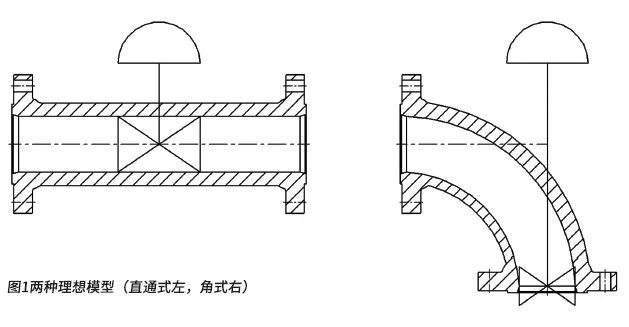
3.1 Structure type of regulating valve
Determining the structure type of the control valve is the first thing that the control valve factory designer needs to determine. The black water working conditions are complex, high pressure difference, and solid particle sedimentation. Therefore, shortening the number of medium flow structures in the control valve is the protection adjustment. The main goal of the valve itself, the ideal adjustment style is divided into two models, straight-through or angle, as shown in the picture above.
Since the straight-through type needs to perform two sharp turns when adjusting the black water, and the straight-through type is not friendly to the settlement of solid particles, it is easy to settle at the bottom of the pipe and the turning point, so an angle with smooth turning and not easy to settle should be selected. type, the flow direction selects side entry and bottom exit. The angular structure can guide the flow of the medium well. When the valve is open, the medium can flow out of the regulating valve without any resistance, which can minimize the impact of the medium on the regulating valve.
3.2 Impact of solid particles on parts
Since the solid particles will have an impact on the parts in the valve, as shown in Figure 2, the parts are directly exposed to the fluid passage, causing the parts to be directly impacted and greatly reducing the service life of the parts. To this end, two parts can be provided. s solution.
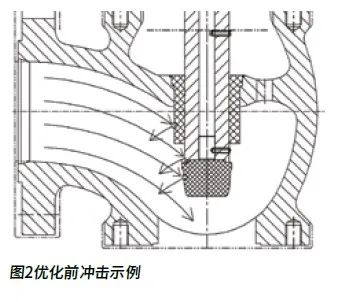
The passage can be dredged, and the flow channel is bent before entering the valve core to guide the fluid to form a certain angle with the valve core, which can greatly weaken the radial impact on the valve core, and also reduce vibration, which is used for the stable operation of the valve. rely on. Parts in the valve should also guide the fluid together with the flow channel, optimize the parts into parts with a certain angle and radian, and reduce the protrusions, steps, grooves, etc. of the parts that may affect the fluid flow and aggravate erosion. The structure that helps to enhance the flow capacity, try to simplify the stages that the fluid goes through when it flows through the components in the valve, and optimize the valve cavity as much as possible to the ideal model of the elbow mentioned above.
3.3 The problem of solid particle settling
The solid particles are small and prone to sedimentation and scaling. It is easy to accumulate in the dead corner of the inner cavity of the regulating valve, and crust on the surface of the valve core, valve seat and valve stem, which will cause the flow capacity to be blocked and stuck, as shown in the figure below. A two-part workaround is provided for this. The result of long-term deposition can also be regarded as the "flow willingness" in the process of fluid flow, that is, the structure of the valve cavity after deposition is the shape of the final flow through which the fluid flows. Fluid pathways have very good models and help.
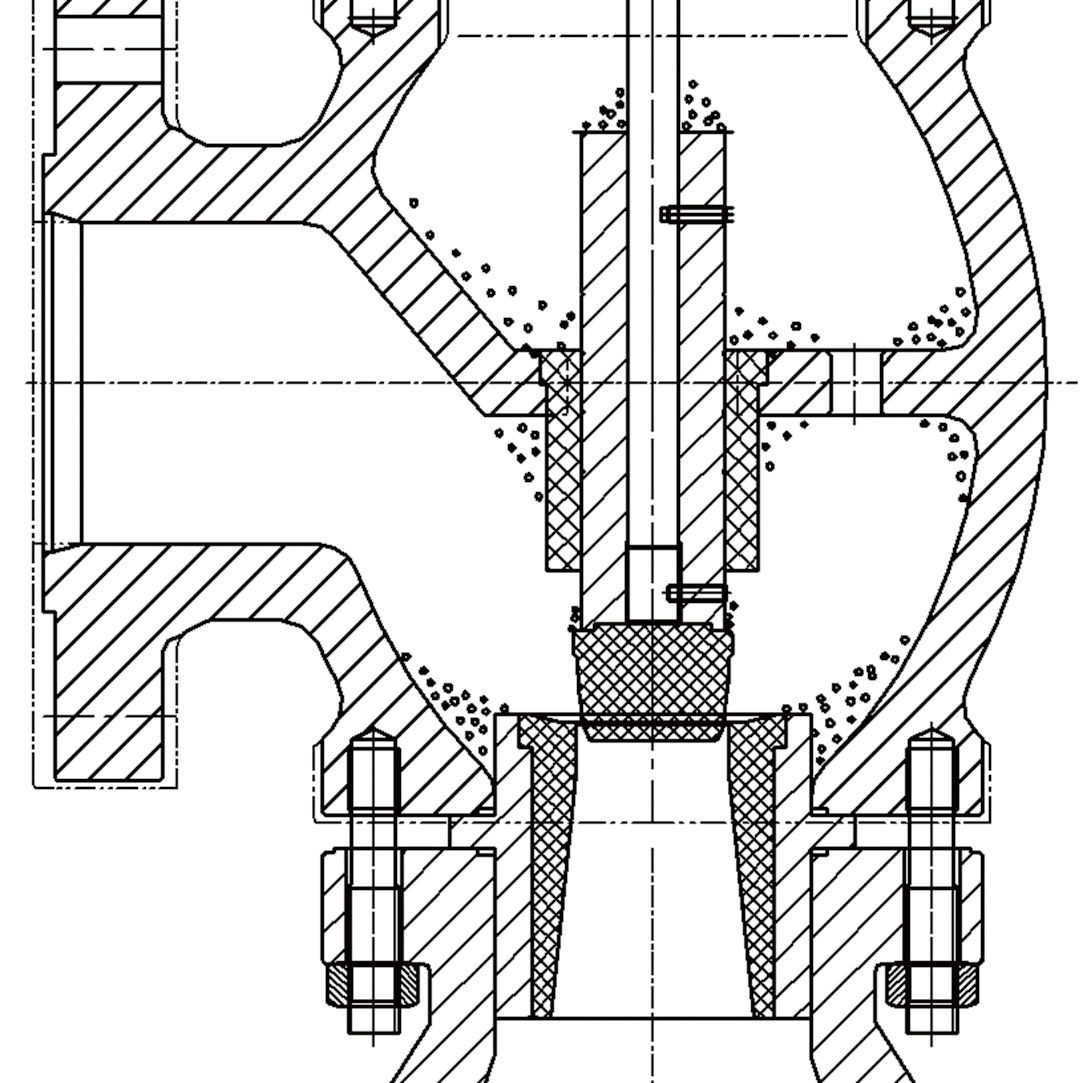
3.3.1 Reduction of deposition sites
Solid particle deposition is likely to occur at corners with low flow rates, steps of parts, etc., so it can actively reduce the static dead corners of the valve cavity and the steps where parts are easy to deposit, so that the fluid can spontaneously carry solid particles during the flow process. Out of the valve cavity, it can reduce the deposition caused by structural problems in the valve cavity. As shown in FIG.
The valve cavity and components are designed to be consistent with the flow direction of the liquid, and the straight edges and end faces of the components are optimized to form an integral streamlined shape with the valve cavity path, which helps reduce the deposition of solid particles and improves the valve. The flow capacity of the cavity structure.
3.3.2 Provide grooming for possible deposition locations
Solid particles cannot avoid adhering to the valve cavity and the surface of the parts under the factors of temperature, solute, pressure and other factors. At this time, it is necessary to have a static drainage or sewage structure for the valve cavity structure and the surface of the parts. Inside the valve cavity, the sewage outlet can be designed for the easy deposition position. The solid particles can be guided to the sewage outlet by gravity through the castable structure such as curved surface, inclination and pit. The fluid can also be used to flush the deposition position, and the auxiliary cleaning can be realized with the help of the fluid. . As shown below.
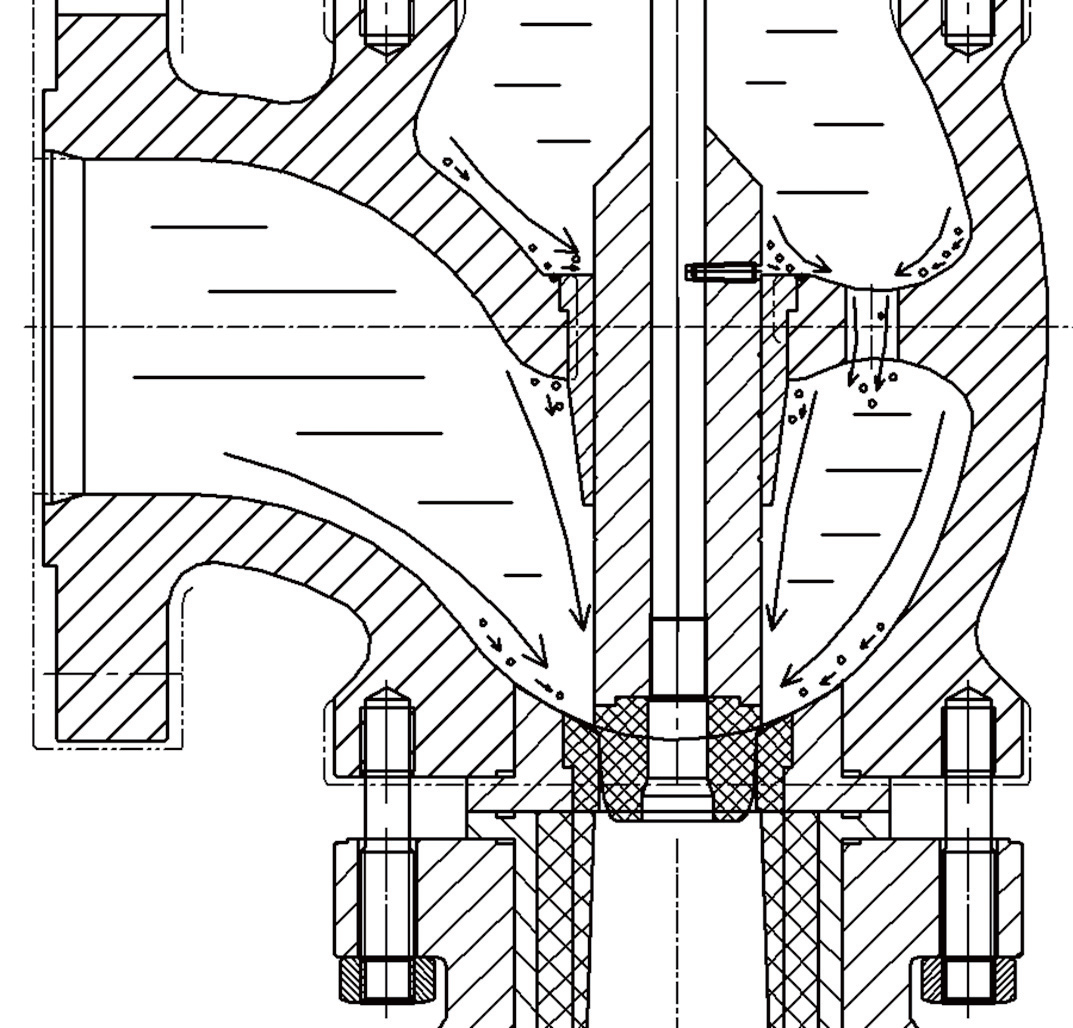
For the guiding part that needs small cooperation, it is unavoidable that the solid particles attach to the mating surface. Therefore, the design idea of spiral ring groove + vertical groove can be selected to hang some solid particles attached to the mating surface and have entered the mating surface. The particles on the surface can be discharged along the ring groove by liquid scouring and gravity, reducing the probability of failure and jamming. The groove shape of the ring groove can be determined according to the design needs, and can also be discharged in cooperation with the fluid passage.
3.4 Liquid Corrosion Problems
When UTMOST china valve factory designing the black water control valve, the corrosiveness in the fluid medium and the scourability of solid particles should be fully considered. The corresponding solutions are provided below.
For the basic pipeline, the transportation effect is greater than the pressure bearing effect, and corrosion-resistant carbon steel or stainless steel with low carbon content can be considered. The spraying method enhances the erosion resistance and corrosion resistance of the pipeline.
For the black water control valve, the pressure bearing effect is greater than the adjustment effect, and austenitic stainless steel or duplex stainless steel with high corrosion resistance and high structural strength can be used. Bearing length and reliability.
3.5 Liquid Shock Problems
The main body of the black water medium is fluid, so the shape and structure of the flow channel inside the valve cavity affect the pressure recovery coefficient of the valve body, and also affect whether a blocked flow, eddy current, turbulent flow, etc. are formed, which is to ensure the stability and safety of the valve body. As a major issue of fluidity, the shape of the fluid pathway plays an important role in fluid design. As shown below.
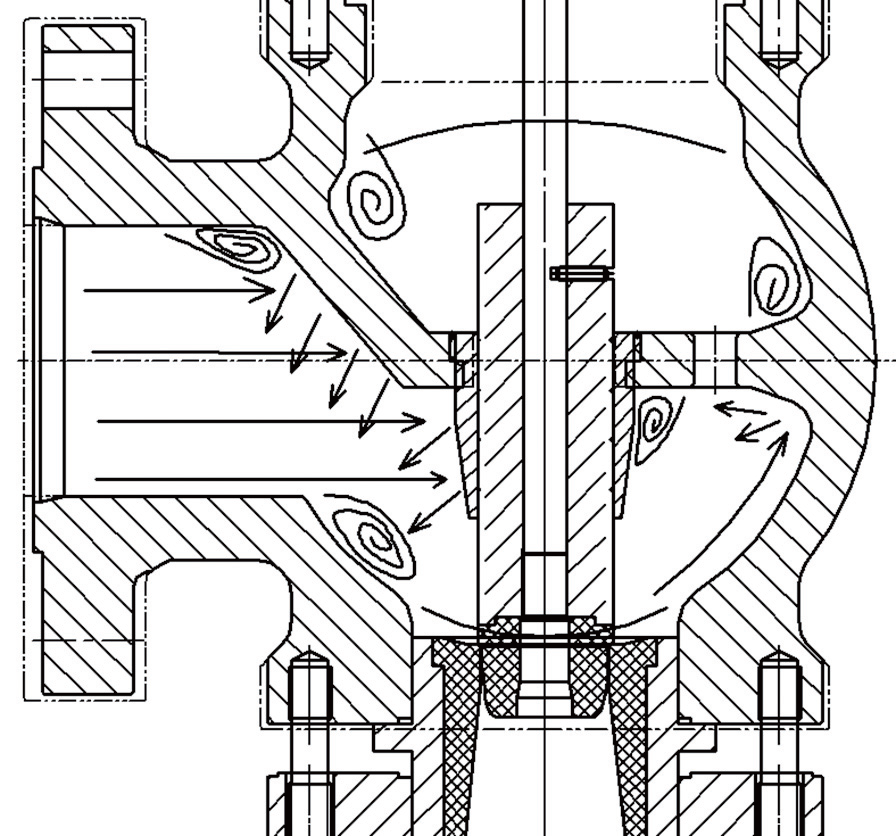
The unreasonable design of the flow channel will make the partition of the inner wall suffer unnecessary impact, the internal steering of the flow channel will be rigid, and the useless grooves in the transition part will make the fluid in a turbulent state during the flow process, resulting in eddy currents inside the valve cavity, Turbulent flow, impact the valve core and valve cavity, causing vibration and damage to the diaphragm inside the valve cavity. The corresponding solutions are provided below. As shown below.
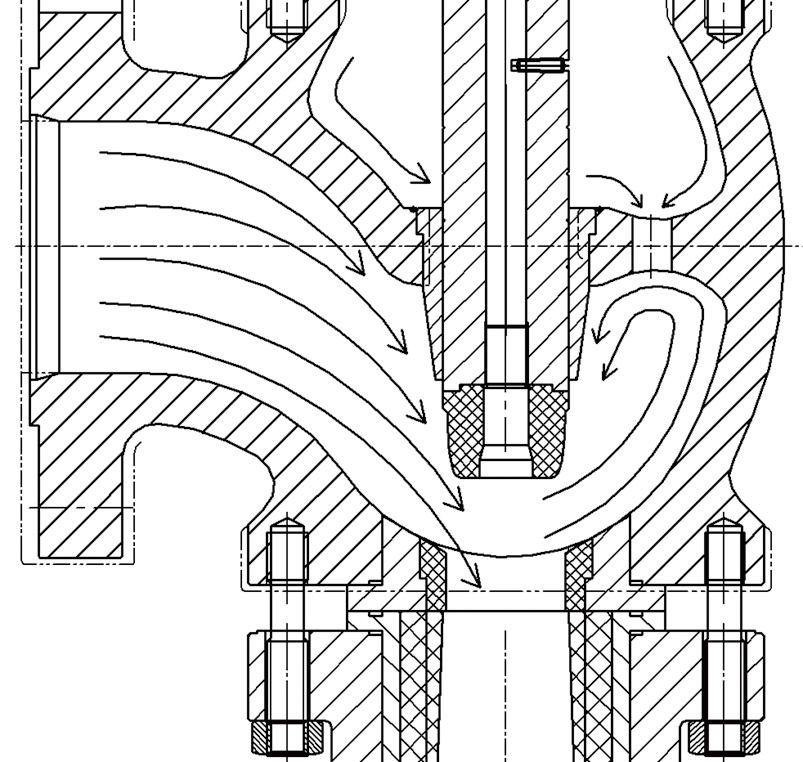
The flow passage of the valve cavity affects the flow capacity of the valve. The stronger the fluidity of the liquid, the stronger the flow capacity, which can reduce the pressure recovery coefficient, make the pressure recovery a little better, and reduce the occurrence of blocked flow, eddy current, turbulent flow and turbulent flow, which means The valve body should adopt a better streamlined structure, which can refer to the deposition position of solid particles to improve the smoothness of the flow channel, so that the liquid can flow out of the valve body stably without obstruction, which is the focus of the flow channel design. Of course, the backflow and diversion capacity of the flow channel can also be appropriately increased, so that the cavity of the valve body can evenly carry the liquid pressure. The backflow and diversion can reduce the pressure on one side of the valve core and help stabilize the valve core. The design of the body flow channel can do more with less.
3.6 Response to flash evaporation and cavitation effects
Since the black water regulating valve needs to deal with the liquid vaporization caused by the high pressure difference at the valve outlet and the cavitation effect caused by the volume expansion, this stage will cause a serious scouring effect on the valve seat outlet and downstream pipelines. At this time, the structural design The role it can play is relatively limited, and other methods can only be considered to improve export conditions.
If a noise reduction plate is installed at the valve outlet, the pressure at the valve outlet can be increased, the pressure difference at the valve seat outlet can be reduced, and the liquid gasification conditions can be improved by controlling the liquid to be within the saturated vapor pressure at the current temperature. However, the pressure behind the noise reduction panel is still very high, which will cause a secondary impact on the downstream pipeline and valve. High flow rate and large volume will cause the downstream pipeline to vibrate violently, which may damage the inlet of downstream equipment.
At present, the feasible method is to install a venturi expanding pipe at the outlet of the internal valve seat, lengthen the venturi expanding length, control the gasification phenomenon in the high-strength venturi pipe, and protect the downstream pipeline and equipment. At the same time, since flash evaporation is unavoidable, the strength of the valve seat, valve core, and venturi can be passively increased, and the strength of the local structure can be enhanced by spraying or through-body cemented carbide.
Externally, a large-diameter buffer tank can be installed after the venturi tube, and the downstream pipeline can be thickened or surfacing, sprayed with wear-resistant materials such as cemented carbide, etc. At the same time, the influence of high-frequency vibration and noise at the outlet of the black water control valve should also be considered in advance in the pipeline laying stage, which can enhance the pipeline support design and anti-vibration measures to ensure that the entire process line can run stably for a long time.
As a representative of harsh working conditions in the design of coal chemical industry, black water control valve tests the design level and experience of every designer. Designers need to find a balance point from the three contradictory directions of cost, effect and use, and lay a good foundation for the good quality of the valve.